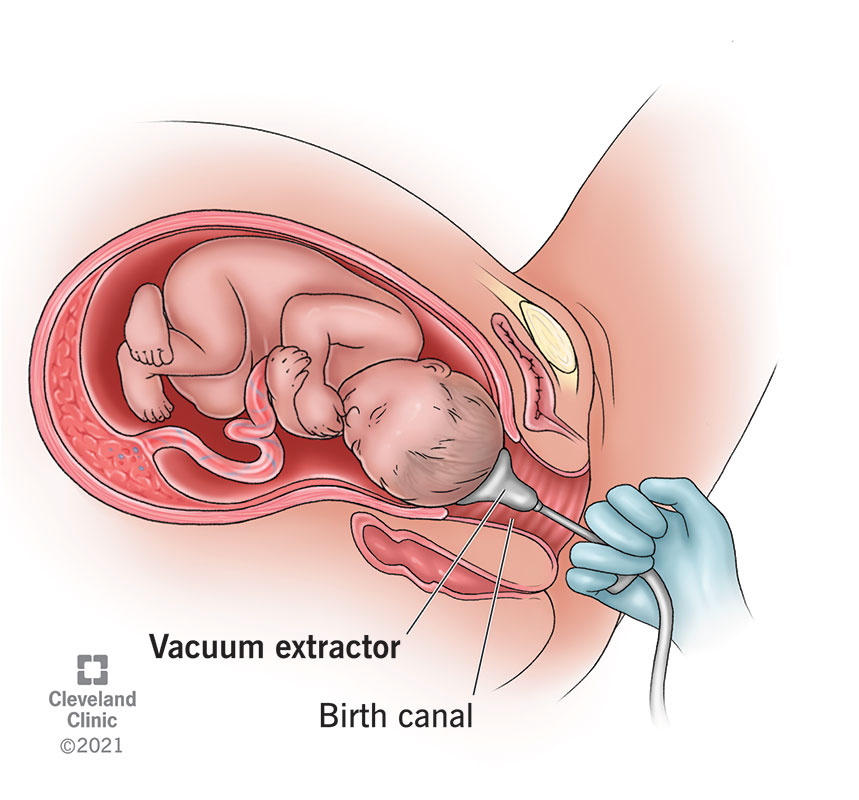Vacuum extraction is one kind of assisted delivery procedure that can help get your baby through the birth canal when labor is stalled in the second stage. The vacuum extractor applies suction and traction to the baby’s head to help pull it out while you push. Vacuum extraction is only recommended under certain conditions.
Advertisement
Cleveland Clinic is a non-profit academic medical center. Advertising on our site helps support our mission. We do not endorse non-Cleveland Clinic products or services. Policy

Vacuum extraction (or vacuum-assisted delivery) is one way obstetricians can assist with the delivery of your baby while you’re pushing. During the pushing stage of labor, sometimes things slow down. You’re pushing, but your baby isn’t coming out. This can last for hours without much progress. While you’re in labor, your healthcare team will monitor your vital signs and your baby’s heart rate for signs of fetal distress. If you or your baby’s health is in danger or labor isn’t progressing, your healthcare team may look for other ways to deliver your baby.
Advertisement
Cleveland Clinic is a non-profit academic medical center. Advertising on our site helps support our mission. We do not endorse non-Cleveland Clinic products or services. Policy
Vacuum extraction is one such option. The vacuum extractor consists of a suction cup attached to a pump. The cup is applied to your baby’s head while the pump provides traction to pull while you push.
In the United States, vacuum extraction accounts for about 3% of vaginal births.
Your healthcare team may suggest vacuum extraction if:
Before using a vacuum, your healthcare team may try to:
If these steps don’t help, your healthcare team may recommend an assisted delivery method like vacuum extraction or forceps delivery.
Sometimes, you might need assistance, but vacuum extraction isn’t the right choice. This might be true if your baby:
Your pregnancy care provider will explain the risks and benefits and ask for your consent before starting. If needed, they’ll give you pain relief. Sometimes, they may also need to cut the area between your vagina and anus (called an episiotomy) or break your water.
Advertisement
Your provider will place the suction cup on your baby’s head. When your next contraction starts, they’ll gently pull while you push. The suction adds extra help to get your baby out. Once your baby’s head is out, they remove the cup. Then, your provider helps guide the rest of your baby’s body out with their hands.
Your providers will stop using the vacuum extractor if any of the following are true:
Once your baby has been completely delivered, your healthcare team will check you and your baby for any signs of wounding from the procedure. If you had a tear or an episiotomy, they’ll repair it for you. They’ll continue to monitor your baby for any signs of complications that might arise.
If vacuum extraction is unsuccessful, your healthcare team may recommend a C-section next.
Vacuum extraction can help deliver your baby without putting you through surgery. It’s also faster than surgery, which is sometimes very important.
Risks to the mother from vacuum-assisted delivery are similar to the risks of childbirth, in general. They include:
Short-term side effects of vacuum extraction for the baby can include:
Serious complications for your baby are rare. They can include:
Advertisement
If there are no complications, you’ll recover in about six weeks (typical recovery time for a vaginal delivery).
If your baby has any of the common short-term side effects of vacuum delivery, such as bruising, jaundice or scalp swelling, these will improve over the next few weeks. Take extra care to protect your baby’s head while it heals, and make sure to bring them in for follow-up checkups with their pediatrician.
Many parents hope and plan for a simple vaginal birth, but childbirth can have its twists and turns. When difficulties arise, it’s good to know the options available to you. Vacuum extraction is one tool that you and your healthcare provider might choose to help deliver your baby.
As you plan for delivery, you can discuss interventions like vacuum extraction with your healthcare provider in advance. They’ll help you understand the risks and benefits, and make a plan for how to proceed if you need help delivering your baby.
Advertisement
Cleveland Clinic childbirth experts coach you through every step — from labor to delivery to what to expect when you and your newborn head home.

Last reviewed on 04/25/2025.
Learn more about the Health Library and our editorial process.